Barefoot shoes, basketball, and how to avoid recurring calf strains
- How I started getting into the shoespiracy topic
- Zero-drop shoes
- Realization 1: Elevated-heel shoes probably messed up my posture
- Realization 2: Elevated-heel shoes atrophied my calves
- Realization 3: Elevated-heel shoes created more heel striking in my running gait
- Origins of elevated heels?
- Zero-drop shoes and basketball
- Barefoot shoes and biking
- Toe spreading
- Conclusion
How I started getting into the shoespiracy topic
A few months ago, I wrote a post called Trying to back back to normal where I described my attempts to resume playing basketball after a year-long hiatus with the pandemic. Although I’ve been playing basketball since I was a kid, for the past 5 years I’ve suffered recurring calf strains that have required a lot of time off court to rest and heal. Every couple of months, I tended to strain my calf and had to sit out for 3-4 weeks to allow it to heal. I’d been to numerous physical therapists and hadn’t been able to figure out what the underlying problem was.
About six months ago, I even decided to change things up and visited a chiropractor who specializes in Active Release therapy (ART). He performed some magic massage on my calf muscles (using a technique that involves pinning and stretching the muscles) that seemed to have good success. After a few ART sessions on my calves, I thought he had fixed the issue, but after a couple of months of playing, I strained my calf again, and then again, and then again. Three more times, but in different parts of the calf each time. This confused me and made me think there might be structural problems causing the issue.
Added to this, I also started having patellofemoral syndrome (misalignment of the knee cap) with my knee, and I experienced hamstring pain due to friction on my sciatic nerve (not on the same leg with the problematic calf, though). I could barely run up and down the court without pain. I wondered if I’d perhaps come to the end of my basketball playing days. I am, after all, 46 years old. Maybe I’d simply worn my legs and knees out?
I tried biking more, and thought perhaps I could replace basketball with cycling. But during cycling, the knee pain from the patellofemoral syndrome would kick in after about 5 miles, and this blocked me more immersion with the bike. Plus, my preference was for basketball more than biking anyway.
Last month I decided to see a physical therapist (PT) again. I explained that I had three recent calf strains in different parts of my right calf. After some diagnostics, he said I had some anterior pelvic tilt and rib flare, which led to some incorrect posture. He said I had too much curvature in my lower back and needed to push out my lower back more. He said I was overusing my knees rather than relying more on my glutes for power. He identified some weak muscles in my legs and hips that needed strengthening, and gave me daily exercises to do.
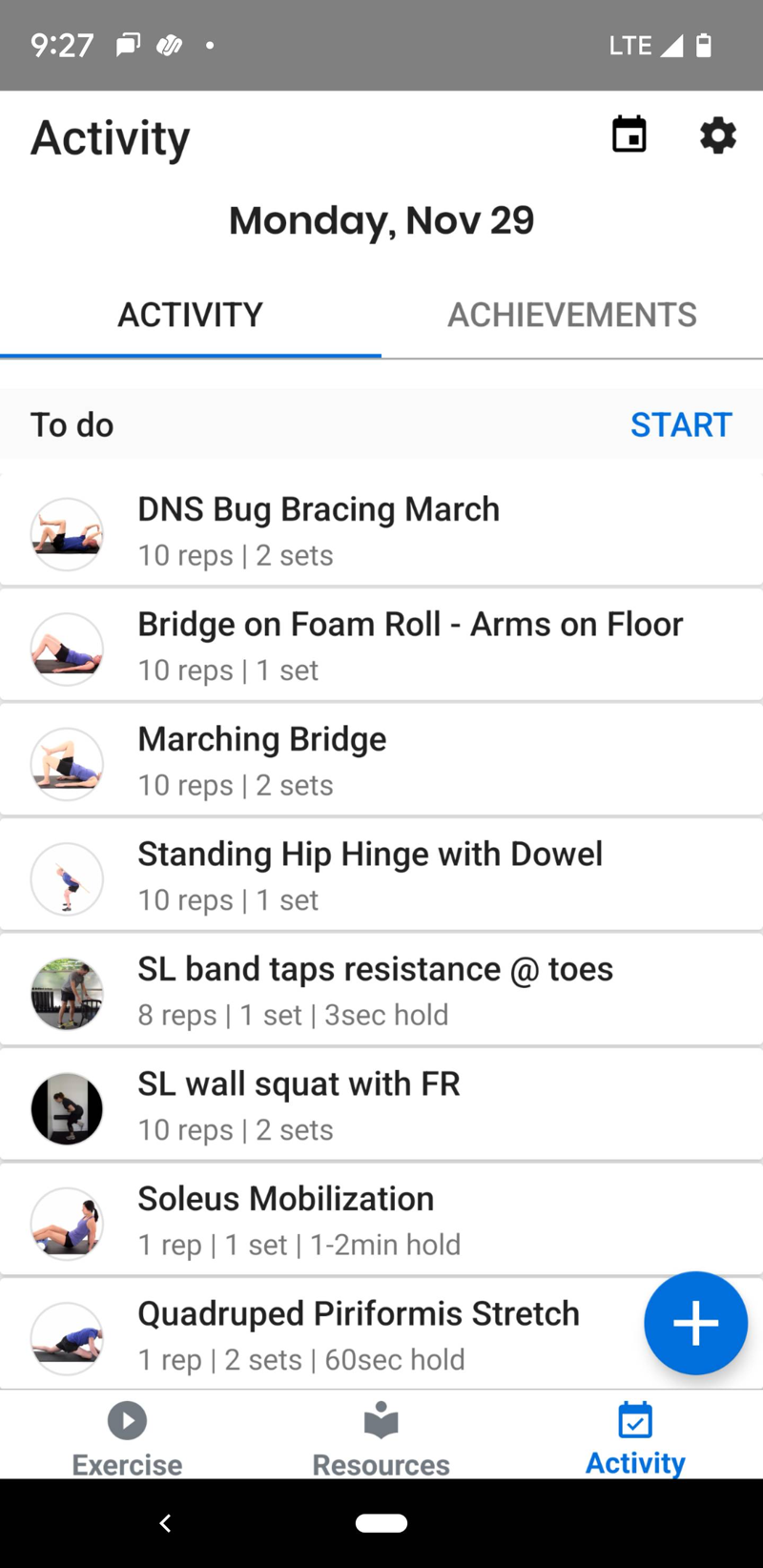
He also recommended that I look into “zero-drop” shoes for basketball. I’d never heard of zero-drop shoes before because I’m not a runner and wasn’t familiar with the barefoot running movement. After some initial research, the recommendation for zero-drop shoes set me on course for cult-like education and awakening around a barefoot running like nothing I’ve ever experienced. Pretty much all I did during Thanksgiving break was read about barefoot shoes. For a primer, see this Shoespiracy video.
Zero-drop shoes
Let’s dive into the shoe topic in depth. A good deal of your posture issues can be attributed to the shoes you wear. “Zero-drop” refers to the drop in height from the heel to the toe, with zero-drop having no change in height. In contrast, most shoes have a wedged heel, elevating it more than the toe. To try out zero-drop shoes, I ordered a pair of Prio shoes from Xero shoes and immediately fell in love with them.
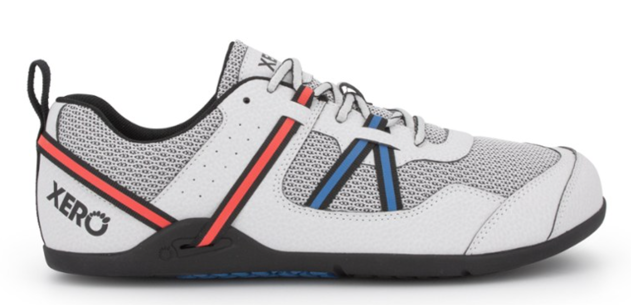
These shoes belong to a category of barefoot/minimalist shoes (see more shoe options here). Not only are barefoot/minimalist shoes zero-drop, they also have wide toe boxes, which gives your toes room to spread. And they also have a minimal sole, allowing your foot to feel the ground. Zero-drop shoes are closely associated with the barefoot running movement, which use minimalist shoes to simulate running barefoot. Barefoot shoes still involves wearing shoes, but while walking around in them, it feels close to being barefoot.
Wearing these shoes for just two weeks has led me to several realizations:
- Realization 1: Elevated-heel shoes probably messed up my posture
- Realization 2: Elevated-heel shoes atrophied my calves
- Realization 3: Elevated-heel shoes created more heel striking in my running gait
Realization 1: Elevated-heel shoes probably messed up my posture
Wearing the zero-drop shoes, I immediately noticed a change in my posture. Rather than leaning back, I actually started using more correct posture — straightening up more, with my lower back pushing out — because of the zero-drop heel. It’s difficult to describe, so here’s a picture that represents the changes in posture that I feel happened.

Wearing elevated-heel shoes, my hips tilted forward a bit. To offset that forward hip tilt, I think I leaned back a bit for balance. As I leaned back, this created a hyper curvature in my lower back. It’s no wonder that standing for long periods of time with elevated-heel shoes would frequently make my lower back hurt. Now the reason seems obvious. I had no idea that elevated-heel shoes affected my posture so much. Other running experts explain the impact of the elevated heel in more detail. John Goldthrop writes:
When standing while wearing an elevated heel, your center of mass is shifted slightly forward. Although this positional shift is small, it has large consequences for your entire body. Starting at the feet, your weight shifts towards the forefoot. This reduces overall stability because now, instead of owning a tripod of pressure evenly distributed on your heel, inner and outer forefoot, you have taken some pressure off the heel.
The calves and front of the knees get overloaded due to this shift, too. This is because they are turned on all day, preventing you from falling forward. Try walking up steps by pushing through the toes versus evenly through your whole foot. Which feels better on the knees? Whole foot, no doubt.
Next, your pelvis will rotate anteriorly which means your hip flexors shorten and your low back arches excessively. This leads to overactive low back muscles and inhibited, weak abdominal muscles. There’s even some talk about what shifting your pelvis like this does to your internal organs (google: visceroptosis) though I’m not sure I’m ready to be that dramatic.
Oh, and if your hip flexors and low back get tight while your abdominals become inhibited, you can practically kiss your butt muscles bye-bye! Don’t get me started on that ;-) (Shoe Flaw #2: The Elevated Heel)
When I replaced the elevated-heel shoes (in this case, Hoka Hoka Clifton running shoes) with zero-drop shoes, my posture naturally adjusted to more of a straightened back. And to my surprise, my back didn’t hurt while standing for long periods of time. I haven’t adopted a standing desk (nor plan to), but the change in posture is definitely noticeable and the reduction of lower back pain was practically immediate. Correcting this posture had downstream benefits to my legs, knees, and calves.
Realization 2: Elevated-heel shoes atrophied my calves
Wearing elevated-heel shoes pretty much all my life (not just on the court), my calf muscles shortened and atrophied. When I would play basketball, the jumping and other gameplay movements would at times stress my calf muscles, and because my calf muscles were shortened/atrophied through elevated-heel shoes, my calves couldn’t stand the strain. A healthy calf muscle allows a full extension without straining the muscle. The following diagram shows how the elevated-heel shortened and atrophied my calves.

As many barefoot enthusiasts say, any time you put a limb in a cast, it weakens the limb, and many shoes are similar to casts, especially if they restrict movement (like the elevated heel). However, my theory isn’t entirely sound because I’m only experiencing calf strains in my right calf. I haven’t strained my left calf (not for at least three years anyway). Yet it’s not as if I’m wearing different shoes (one wedged, one flat) on each foot. I wear the same shoes on each foot, but with different outcomes.
It’s here that I should repeat that I’m not a foot expert nor have I entrenched myself in research here. I’m just speaking mostly from my own experience and sharing my thoughts, enthusiasm, and optimism for a fix. However, I can’t help but wonder if modern basketball shoes are driving more injuries than in the past. In The NBA’s Most Devastating Injury, Melissa Rohlin explains:
Dr. Matt Provencher, FOX Sports’ injury expert and the former team physician for the New England Patriots, said there has been a 5 to 8 percent increase in Achilles tears among NBA players the past two years, according to 15 years of data that his company, Proven Performance Technology, has analyzed.
“There’s certainly a slightly higher incidence of it,” Provencher said. “It’s hard to say why.”
Why is it that as basketball shoes become more high-tech, with better support, cushioning, energy return, explosiveness, etc., the more injuries take place? Shouldn’t these shoes lead to a decrease in NBA’s most devastating injuries? This correlation would bring into suspicion much of modern basketball shoe design.
Realization 3: Elevated-heel shoes created more heel striking in my running gait
My third realization was that I run with a heel-striking pattern while playing basketball (running up and down the court, which is the only time I run). I’m not a runner, so the whole language of heel-striking and mid-striking isn’t that familiar to me. But as I ran in zero-drop shoes (for short durations — about 30 seconds to a minute, which is recommended during the transition to barefoot shoes), I realized that my running form changed. I started to naturally prefer more of a mid-strike (landing in the middle of the foot) rather than a heel-strike (landing on the heel). See this video for more detail about heel-striking versus mid-foot striking: Running Form: The Mid-Foot Strike.
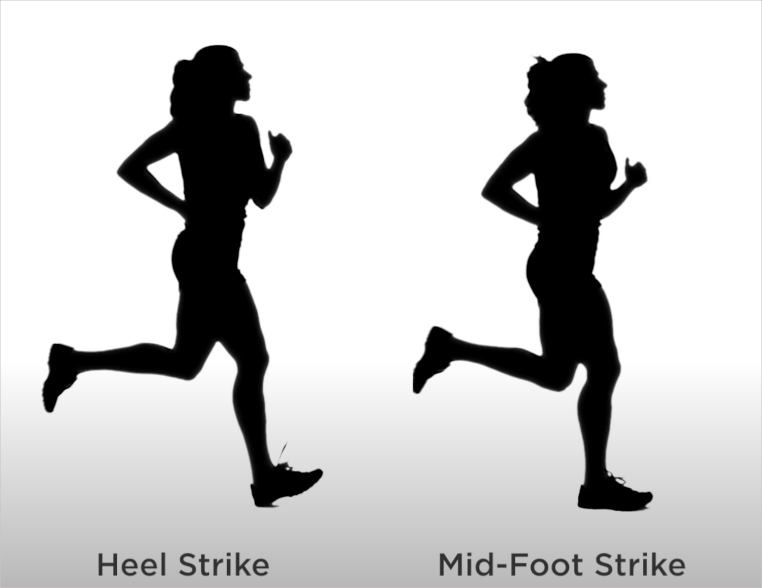
In contrast, when wearing elevated-heel shoes, as I ran I would naturally use more of a heel-strike motion because the wedged heel sticks out more and naturally hits the ground first. (With basketball shoes, because the wedged heel is so pronounced, you have to consciously lift your foot up more to avoid heel-striking.) The heel-strike would send more shockwaves up my knee, which I think contributed to my patellofemoral pain and joint soreness. If you ever look at professional basketball players on the sidelines, they often have massive ice packs wrapped around their knees, even when they’re only subbed out temporarily. There’s a lot of force that transfers into your knees and other joints. It turns out that simply adjusting to a midstriking gait reduces a lot of the impact.
The idea of barefoot running is that when you run barefoot, you adopt a proper running form because improper form hurts. You naturally adopt a more mid-strike to your running gait because this feels best. And you return to the primal/natural running form that humans have used for thousands of years before shoes (or with minimal shoes such as animal skins).
While running up and down the court, I changed my running gait to not only mid-strike, but also to pull my feet up under me and take more steps. Steven Sashen, co-founder of Xero Shoes, describes the motion of pulling your feet up as if you were stung by a bee (rather than pushing off with each step to drive forward). In sum, the changes invoked by barefoot shoes were shorter steps, mid-striking, and pulling up on the feet.
Origins of elevated heels?
You might wonder, why did shoe designers ever start adding elevated heels in the first place? Some say the wedged heel better allowed boots to fit securely into stirrups while riding a horse. When these same people (who had become accustomed to wedged boots) started wearing athletic shoes without the heel, they complained of sore calves/achilles, so shoe designers started adding the wedge to athletic shoes too. Other sources I’ve read trace the elevated heel and platform shoes to ancient Greece as a status symbol. Heels make also our legs taller, which plugs into ideas of beauty that involve longer legs.
Whatever the reason, it seems hard to believe that a heel, which is almost universally present in shoes, is an unnecessary vestige from a former horse-riding period. And it does still have a purpose outside of stirrups — the elevated heel makes it easier to walk. If you walk around a city in barefoot shoes, you realize how much harder it is to walk. A mile in barefoot shoes is not an insignificant distance. Add an elevated heel and a stiffer sole, and you can walk farther with less strain. But at a cost — atrophied calves and feet.
Zero-drop shoes and basketball
Although I think barefoot/minimalist shoes work fine for most activities, when it comes to basketball, I’m still not courageous enough to wear them. Basketball has a lot of jumping, cutting, pivoting, and other lateral moves. Also, my feet haven’t strengthened enough to the point where I could play in minimalist shoes competitively without injury.
At some point, maybe in six months or so (once my feet have strengthened), I might try to graduate to shoes with a lower heel to play. I experimented a bit with Altra Solstice XTs (a cross-training shoe) based on the recommendations in this article from Correcttoes.com, Basketball and Natural Footwear Options. The Solstice XTs have an extra wide toe box and zero drop heel, but they also have quite a bit of cushion (so they’re not minimalist shoes at all). Traction is all right. They might work on the court at some point when I’m ready to transition to them during gameplay.
Even though I’m still wearing regular basketball shoes, I believe that as long as I wear barefoot shoes everywhere else, the brief time in basketball shoes won’t roll back my other gains. I’m still searching for a good basketball shoe with a lower heel (not necessarily zero-drop, just lower), but so far, it’s like searching for a purple unicorn. (My friend at weartesters recommends the Dame 7, which I plan to try out.). The basketball industry emphasizes a design with massive heal wedges, which tilt players down into more of a forward motion, making it easier to run and dart forward. Maybe this forward tilt suits the body’s motion during game play, but it also encourages more weight to be positioned over your knees and affects your posture, including your shot.
There’s also a bit of controversy about whether zero-drop shoes are even desirable for basketball. In the comment thread on this Reddit post, some suggest that without some heel lift, landing with a lot of force could push your heel below the zero-drop mark, which could stress your achilles. “EfficientZone” writes:
… marrying any type of cushioning with a low or zero heel elevation is a terrible idea for the reason that upon compression you may actually get a negative drop (hi, my dear inflamed achilles tendon!). It’s even worse of an idea for basketball shoes where heel-impact - and therefore significant heel-compression - is unavoidable. How is heel-impact unavoidable in basketball? Barefoot/minimal runners may entertain the fantasy that they are all forefoot strikers, but for basketball almost any jump landing involves a landing pattern with the forefoot striking the ground first followed by a rapid transition of impact forces to the heel. Typically on graphs measuring ground reaction forces for jump landings there are two peaks, a sharp but small peak corresponding to the initial forefoot landing followed by a much larger peak as one’s body-weight shifts to the heel. Jump landings are ubiquitous in basketball: shot contest, jump shot, layup, rebound, etc. etc. Furthermore, heel-impact isn’t restricted to just landings. Whenever a player gears up for a lay-up their first step will involve a strong heel plant as they charge towards the rim. The fact of the matter is that heel cushioning in basketball matters and the fact is that any foam cushioning in the heel will compress as it absorbs impact. So what happens when I heavily compress the heel of my zero-drop shoe? Ah yes, I say hi again to my dear over-stretched and inflamed achilles tendon.
There are good reasons for why the industry standard heel-to-toe drop for bball shoes has historically been roughly 10mm. A) you have to account for the degradation of the cushioning foam with repeated impact, thus leading to a lower drop over time; B) heel compression upon impact should never lead to a negative drop or any case where a user’s achilles may be over-stretched. Thus the 10mm drop provides a conservative safety buffer.
The author makes a good point. I certainly wouldn’t want my calf to extend in a negative drop. I’m not sure what’s true there, but one thing I’m pretty certain about: I wouldn’t wear basketball shoes off the court as casual shoes, as many people do.
Correct Toes acknowledges that no current basketball shoes meets the criteria for minimalist shoes. They say, “we understand there aren’t any ideal athletic shoes out there that have been able to merge the concepts of natural foot health with basketball performance” (Basketball and Natural Footwear Options). And then they recommend some basketball shoes that seem to have wider toe boxes and perhaps lower-elevated heel. (It’s hard to know because athletic shoes almost never mention toe box width or heel drop in the shoe specs.)
Right now, I’m okay with playing basketball in elevated-heel shoes. Walking around in zero-drop shoes (even a mile) makes you aware of how much of a workout your calf is getting. Wearing barefoot shoes, I feel like my calf muscles are getting a serious workout and coming out of a coma for the first time. I find myself regularly stretching my calf and rotating around my ankle.
Playing ball in elevated-heel shoes might be like putting a safety threshold on how much the calf can extend. If the heel can prevent my calf from over-extending and thus straining or pulling the muscle, then I’m all for it. Right now my calves and feet are weak, and if I had to run up and down the court with a barefoot shoe, I honestly don’t think I’d last long, even without any regard for lateral movements or cutting, jumping, and driving. Just the constant running alone on hardwood floor/cement (back and forth 75+ times) would be unbearable. But walking and training in barefoot shoes seems like a solid way to strengthen my calves, and other sources agree.
Barefoot shoes and biking
To strengthen my calves and feet, I try to wear barefoot/minimal shoes everywhere I can, even when riding my bike. However, if you’ve ever tried riding barefoot with spiked pedals, you know how painful this can be. And yet, I didn’t want to carry around barefoot shoes only to wear them ocassionaly walking around at work. So I swapped out my pedals for some flat platform city pedals (by Look), and this setup seems to work all right.
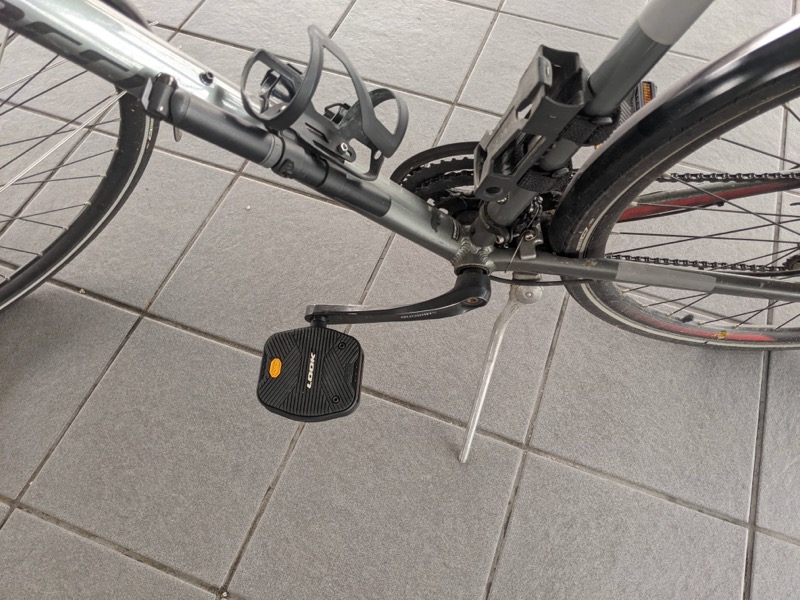
I would only recommend using these flat pedals for casual riding, which includes stop-and-go type riding in cities. (Even in the rain, the pedals aren’t that slippery.) You do lose power by not having a stiffer shoe, and if you were to ever try mountain biking, you might risk foot injury.
But I want to maximize my time in barefoot shoes. Currently, the bike segment of my work commute isn’t that long (< 5 miles). However, I spend some time walking up and down stairs in train stations, waiting or standing on the platform and train, and more. So I wanted to reap the benefits of minimal shoes as much as possible. Plus, with a bike commute, I don’t have infinite space to carry multiple pairs of shoes.
Toe spreading
There’s one more interesting aspect to barefoot shoes: toe spreading. In my quest for zero-drop basketball shoes, I neglected to mention that there are plenty of retro-style basketball shoes making a comeback in style. However, these shoes don’t work for me because they almost univerally have narrow toe boxes (with stiff leather fabric). Wearing the Xero Prio shoes for two weeks, I noticed that my feet started to spread a bit, which is what’s supposed to happen. Toes aren’t supposed to be narrow and close together; they’re supposed to be like the fingers on your hand that spread out.
Take a look at how wide the toe boxes are in these Xero Prio shoes:
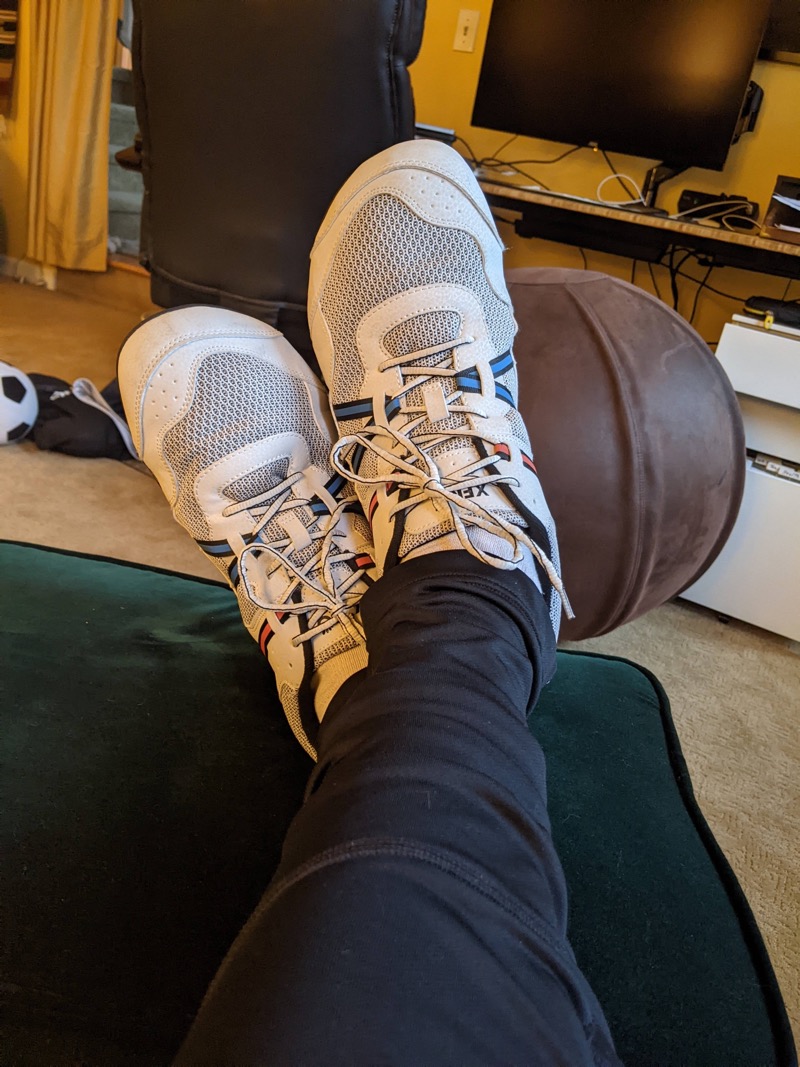
In fact, after wearing the barefoot shoes for a week, when I played basketball in my regular basketball shoes (Lebron 16 Oreos), I started getting a blister on my big toe, which wasn’t a place callouses existed previously. The blister formed because my toes started to spread a little, I think. (For a before-and-after foot pic of someone’s journey to barefoot shoe adoption, see Being Me: A Journey to Barefoot on Anya’s reviews. I won’t subject anyone to pictures of my bare feet here.)
After feeling how comfortable a wide toe box is, it’s hard to even think of going back to narrow-toed shoes. I also have a second toe that’s longer than my big toe by a quarter inch. For years, I’d accepted that this toe will just be jammed in shoes, so much that the toenail is black and has been for years (and I’ve always been unjustly shamed by the longer second toe as well). But after relaxing in wide toe-box shoes, my long toe doesn’t want to go back into shoes with tiny toe boxes. I’ve had a long talk with the toe, and it’s adamant about retaining its freedom.
I did, however, switch out my Lebron 16 basketball shoes for ones that have a more flexible cloth in the toe area and are as wide as possible. I also sized up from a 13 to 14 for more room. I am currently wearing Giannis Immortality shoes and find them to be decent (and surprisingly inexpensive). Someone at Nike has a thing for narrow toe boxes, but with cloth fabric, the narrow cut is tolerable.
Once you make the switch to zero-drop shoes, it’s hard to wear anything else. When I put on any other shoes, it feels like I’m wearing high-heel shoes. And every time I have to put on shoes with an elevated heel, I feel like I’m regressing with the healing of my feet and calves.
Conclusion
I’m still early into my minimalist footwear journey, but I wanted to share it here. If this switch truly proves to fix my recurring calf strain issue, then I’ll be the biggest promoter of barefoot shoes for basketball players ever (just off the court, mostly). And my disillusion with the shoe industry will grow stronger. Already, I am constantly noticing the degree of heel-to-toe drop in everyone’s shoes around me. Fortunately, my kids are into Converse and Vans, which both have near zero-drop (but narrow toe boxes).
If you do experiment with barefoot shoes, take the advice many give to go easy and slowly transition into them. If you switch to barefoot shoes and immediately go run several miles, your feet will ache and you’ll risk injury. Because I’m not a runner, I’ve mostly been walking around in barefoot shoes, and even this walking is minimal. Consider the analogy of removing a cast from your foot — it will take weeks of slow re-integration, little by little, before you regain mobility and strength. But even in two weeks, I’m floored by the results (combined with the PT exercises, which I do daily) and hope that recurring calf strains have become a thing of the past for me.
About Tom Johnson

I'm an API technical writer based in the Seattle area. On this blog, I write about topics related to technical writing and communication — such as software documentation, API documentation, AI, information architecture, content strategy, writing processes, plain language, tech comm careers, and more. Check out my API documentation course if you're looking for more info about documenting APIs. Or see my posts on AI and AI course section for more on the latest in AI and tech comm.
If you're a technical writer and want to keep on top of the latest trends in the tech comm, be sure to subscribe to email updates below. You can also learn more about me or contact me. Finally, note that the opinions I express on my blog are my own points of view, not that of my employer.

